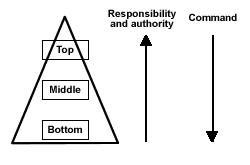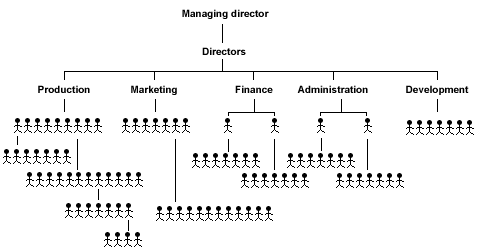Organisation charts and structures
When new employees join a firm, they are often given an ORGANISATION CHART - this is a pictorial representation or diagram showing the functions and departments of a firm and the people within them. Organisation charts are normally shaped like a triangle - this is called a hierarchy as it has a clear top, middle and bottom. This is shown in figure 1 below.

Figure 1 Organisation chart
The position of employees within this hierarchy indicates their status and authority. Those at the top are the most important and are paid a larger salary as they have more responsibility. Each layer of authority is called a level of authority (or command). In a hierarchy, the vertical chain of command can be seen. For instance, the accounts clerk reports to the accounts supervisor, who in turn reports to the accounts manager. Information is communicated up the hierarchy through the layers, and orders are communicated downwards along the same channels.
This structure can be shown formally on an organisation chart and an example of an organisation chart is given in figure 2 below.

Figure 2 Organisation chart
Organisation structures do not show the levels of formality or informality in an organisation. It may be acceptable in some firms to talk more informally and sometimes by-pass the official channels of communication. There are dangers in this as vital information may not reach he appropriate decision maker and they feel marginalised as a result with their authority diminished. In other forms, the structure may be surrounded by rigid rules and procedures and activities are guided by strict rules and procedures laid down in staff manuals. This type of organisation is referred to as a bureaucracy. Precedent is important in making decisions and any situation out of the ordinary will be passed up the hierarchy. Individuals are given little personal initiative. Great regard is paid to a person's position in the hierarchy and their official role.